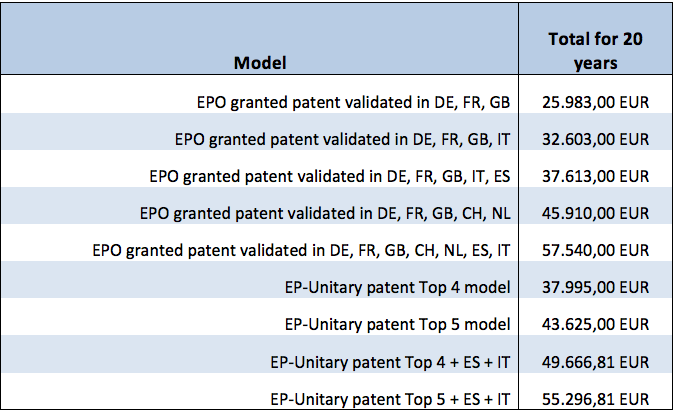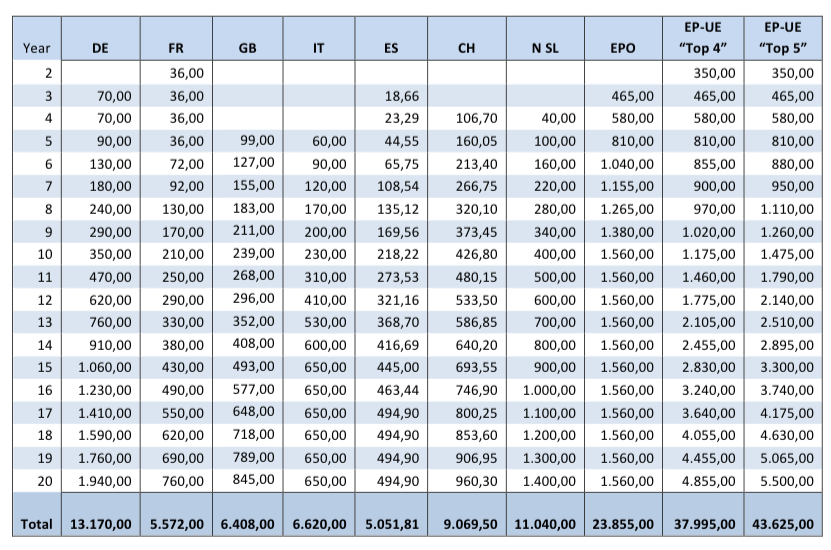A first review of the EPO’s proposals for the EP-UE renewal fees in comparison to the current rates
by Thorsten Bausch and Greg Sach
The EPO, or more specifically the president of the EPO, has recently submitted proposals for the level of renewal fees for the future European Patent with Unitary Effect (EP-UE) to the working group responsible for establishing a fee structure for the EP-UE. This working group consists of the EPO, the 25 EU member states and a number of observers such as EPI, Business Europe, the European Commission and other EPO member states that are not members of the EU. The proposals are for discussion in a meeting scheduled for end of March; if there is no agreement by then, further meetings are planned in May and June. The finalization of the amount of the annuities and the distribution key is expected (or at least hoped for) by end of June 2015.
The proposals are shown in the last two columns of Table I below. Table I also compares the renewal fees for each of the more popular European countries with the new proposals for renewal fees for the EP-UE. All figures shown are in Euro (EUR), based on exchange rates for GBP and CHF as of March 10, 2015.
Table I – renewal fees for various national patents compared with the proposals for the unitary patent
The EPO’s proposals are designated “Top 4 model” and “Top 5 model”. In the Top 4 model, renewal fees for years 10 to 20 are charged at rates intended to be similar to what would currently be paid if the European patent was validated in the four most popular countries for applicants. In the Top 5 model, renewal fees for years 10 to 20 are charged at rates similar to what would currently be paid if the European patent was validated in the five most popular countries for applicants.
The Top 5 model also includes 25% discount for renewal fees in years 1 to 10 for SMEs, individuals, non-profit organizations, universities and public research organizations (not shown in Table 1). This discount will reduce the cumulative renewal fees for the entire 20 years to 41,655 EUR, which is still substantial for a small or medium sized enterprise.
By way of background, a new single patent right for Europe (the European Patent with Unitary Effect) and a new European enforcement and invalidation regime (the Unified Patent Court or UPC) are expected to come into operation soon, potentially as early as the end of 2016. In contrast to the existing European Patent, which operates as a bundle of national patents in each of its designated jurisdictions, the Unitary Patent will be one single right which will be enforceable across the whole of its territory through one action in the UPC. Existing bundle patents granted by the EPO, as well as those granted in the future, will also come under UPC jurisdiction unless opt-out rights are exercised. The Unitary Patent is also to be transferred, licensed, renewed or otherwise dealt with as a single right.
After the unitary patent comes into effect, there will be three possibilities for securing patent protection in Europe: (1) the EP-UE; (2) the classic EP bundle patent which involves separate validations of the European patent (granted by the EPO) in each country of interest and (3) individual national patent applications granted by national patent offices. Note, however, that the territorial coverage of the EP-UE will be smaller than the territory of an EP bundle patent that is validated in all EPO member states. In particular, the EP-UE will likely not extend to Italy, Spain, Poland, the Czech Republic and Croatia at least in the foreseeable future, even though these states continue to be invited to join the EP-UE whenever they wish. So if you wish to cover these territories by a European Patent, you can either use a combination of the EP-UE and a bundle patent validated in IT, ES, PL, CZ and HR; or a bundle patent validated in all states as in the past. In this case, the EP-UE + bundle patent combination will clearly be much less expensive. On the other hand you lose the current advantage of a bundle patent that you may progressively allow your patent to lapse in individual designated states and just keep the patent in “key territories”.
Besides territorial coverage, a significant aspect in deciding whether route 1, 2 or 3 is preferred will be the likely costs of each route. The renewal fees due in each route have been and will continue to be a fairly substantial source of the overall cost of protecting inventions in Europe. In addition to the translation costs arising in many countries, these costs have also been responsible for the fact that approximately 50% of all European Patents are only validated in the Top 3 states DE, FR and GB, and another 40% are validated in the Top 5 states of DE, FR, GB, IT and ES.
A comparison of the total renewals costs for European patents under the current system and under the proposed new system is shown in Table II below for various common validation possibilities under the current system. In Table II, it is assumed that the renewal fees for years 3 and 4 are paid to the EPO at current levels, which is the case for an average patent application before the EPO (42 months pendency on average). In Table II, there is also shown a scenario for cumulated renewal fees where patentee wants protection in Italy and Spain. As mentioned before, Spain and Italy are not covered by the EP-UE, so separate national applications or validations of a granted EPO bundle patent are required in addition to the EP-UE renewal fees.

Table II – a comparison of accumulated renewal fees under the existing and the proposed fees
For reference, accumulated renewal fees over the 20 year life of a US patent are around 13.000 EUR. On top of that, the USPTO offers much more substantial discounts for small entities (50 %) and micro small entities (75 %) over the entire lifetime of the patent.
For the 50% of current EPO applicants used to validating in just the top three most popular countries (DE, FR, GB), the increase in renewal fees, if and when an EP-UE is chosen, will be between around 12.000 EUR (Top 4 model) and around 17.000 EUR (Top 5 model). That would amount to an increase in cumulative renewal fees of between about 46% and 67%. This is not exactly cheap, but obviously the territory of the EP-UE will be significantly larger than the territories of DE, FR and GB combined. Applicants will thus have to decide whether the increased coverage of the unitary patent justifies the additional cost.
About 40% of the EP applicants current validate in DE, FR, GB, IT and ES. For those, the increases in cumulative renewal fees over 20 years will be between around 12.000 EUR to around 17.000 EUR, i.e. between about 32% and 47%.
If one of the EPO’s two proposals is finally accepted, it seems likely that the EP-UE will not become a big success. For the 90% of applicants who are currently happy with protection in five or fewer of Europe’s largest markets, individual validation of an EPO bundle patent according to route 2 or even separate national applications according to route 3 would be the more sensible option based on cost considerations, albeit at the loss of the significant extra coverage provided by the unitary patent.
The current accumulated renewal fees where all of DE, FR, GB, IT, ES, NL and CH are covered is around 57.539 EUR, which is comparable to the accumulated renewal fees for the Top 5 model of the unitary patent + ES and IT, as shown in Table II. Thus, the break-even point for pursuing the EP-UE rather than the presently existing options is more realistically six or more countries for patent protection under the Top 4 scheme and seven or more countries for patent protection under the Top 5 scheme. Accordingly, although the Top 4 and Top 5 models are meant to reflect current renewal fees to be paid where the top four and top five most popular countries are covered, it is closer to a top six and top seven model in reality when you factor in Italy and Spain.
Whether any of these proposals, if implemented, will make the EP-UE attractive for the majority of its potential users, remains to be seen. At least users might now have a better feeling on where this is going and can start planning on a more rational basis.
The authors wish to thank Ms. Sabine Brandl for assistance in compiling the numbers.
________________________
To make sure you do not miss out on regular updates from the Kluwer Patent Blog, please subscribe here.



